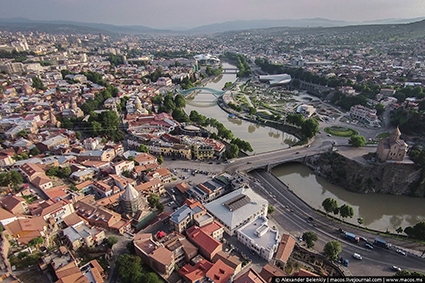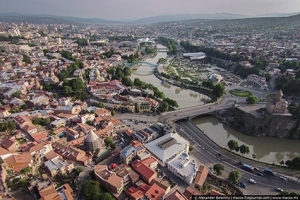UNStudio Helping Georgian Architects and Designers Dream for the Future
It isn’t only a rhetorical question: what will Tbilisi be like in 10 years’ time?
This was the final question posed to participants – a crowd of mostly creative, engaged and remarkably well-groomed students and young people – at a day-long seminar held at Rooms Hotel in Vera this Tuesday.
Titled “The Quality of Life: Rethinking Architecture towards a Sustainable Future,” the seminar was organized by two architectural studios, one – Studio L Tbilisi – Georgian, and one – UNStudio – Dutch, in partnership with the Dutch Embassy to Georgia. This was furthermore the third iteration of UNStudio’s “Dialogue Platform”, a programme of seminars and workshops focused on creative, sustainable design solutions in the our international world. The first two Dialogue Platforms took place in Berlin and Milan.
“We are really specialists of the cross-national,” said Caroline Bos, cofounder of UNStudio and its principal urban planner, explaining the strategy behind these events. “I think we bring that sort of experience with us, but then we interact very strongly with local parties to really work here. Their opinion on what Tbilisi is is far more important than ours.”
Local parties proved – and when don’t they? – the main draw in bringing Dialogue Platform to Georgia. UNStudio, a world-renowned and prize-winning firm, perhaps most commonly identified with the eye-catching Erasmus Bridge in Rotterdam, designed the Kutaisi airport, is engaged with a major master-planned neighborhood project at Tbilisi’s periphery, and has built up a number of personal relationships with Georgians over the years. Ms. Bos, who had never been to Georgia before this trip, pointed out one of UNStudio’s architects helping conduct the seminar, Roman Kristesiashvili.
“He actually brought his baby with him on the plane,” she said, grinning, “to his parents, who are babysitting while he’s here. So that’s an example of globalization!”
The foreign facilitators present were exactly that – facilitators – giving talks on their own projects or practices and, more intimately, leading the small-group workshop sessions interspersed throughout the day. Five topics were introduced to begin conversation with: Historic Preservation, Urban Jungles/Market Research and Planning, Disappearing Public Space, Mobility and the City, and Ecological Identity.
“One of the things that makes Tbilisi unique,” offered one participant, the only non-architect at her table, “is it’s very artsy. It’s a very artsy, culture-centered city, and that’s getting lost.”
The Dutch facilitator turns to the group. “Do you agree with that? That the mixed neighborhoods with a lot of culture and work are disappearing?”
A young man agreed, via translation from his friend, but with a twist. “The main population is not very familiar with the real history of the buildings. For example, the history that during the Soviet period several Soviet leaders stayed in a building, which then changed into a tobacco building…”
“Aha, so he’s saying that the history of these buildings is [being lost]”
“Yes.”
The facilitator folds his extraordinarily long arms and considers this elaborately, for the benefit of the group. “Do we feel we have to go into the neighborhoods, and tell the story that there is more to see in the neighborhoods than what they see right now? That there are a lot of hidden stories in the city? And then get their opinion?” He’s pushing in a particular direction – he doesn’t just want to know about problems and solutions, but how to go about collecting ideas for solutions from the people themselves, on the street, in the ezo.
After the morning workshops, some of the facilitators are exchanging notes about the problems identified, the solutions proposed, even the masterplans brought up. Too much specificity is clearly frustrating for them. The point of today isn’t – couldn’t be – to devise final answers. The point is to help rewire how we think.
With a spur-of-the-moment decision, the plan for the rest of the day was spun on its head. There was a new workshop now, a new question: to write a newspaper headline from the year 2025. What would media in ten years’ time have to say about Tbilisi?
Responses ranged from the playful (a pedestrian killed by a cyclist) to the prescriptive (“Tbilisi Toes to the Sky,” read one presenter, “and if you want some small text under it, it’s: Tbilisi, famous for its beautiful landscape and traditional old Tbilisi courtyards, has established a new city development of neighborhoods in the sky”).
Old Tbilisi courtyards might not be sprouting Portmanesque sky gardens ten years from now, and the ambitious riverside plans showcased or peripheral neighborhood designs – which really are being professionally discussed – might not have the transformative effect we hope. But thinking about Tbilisi as the city we want it to be is a good way to start off getting there.
Robert Isaf












